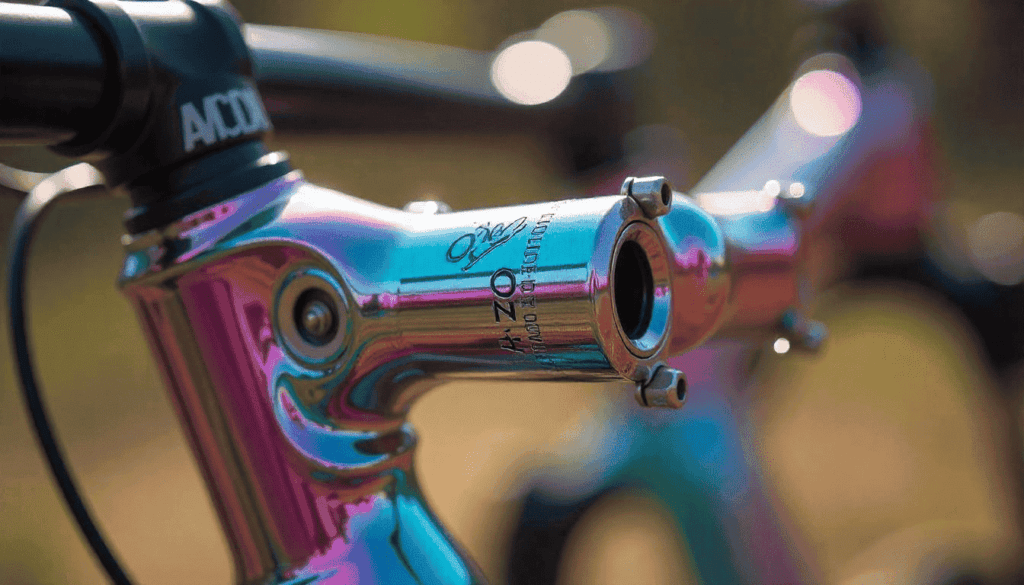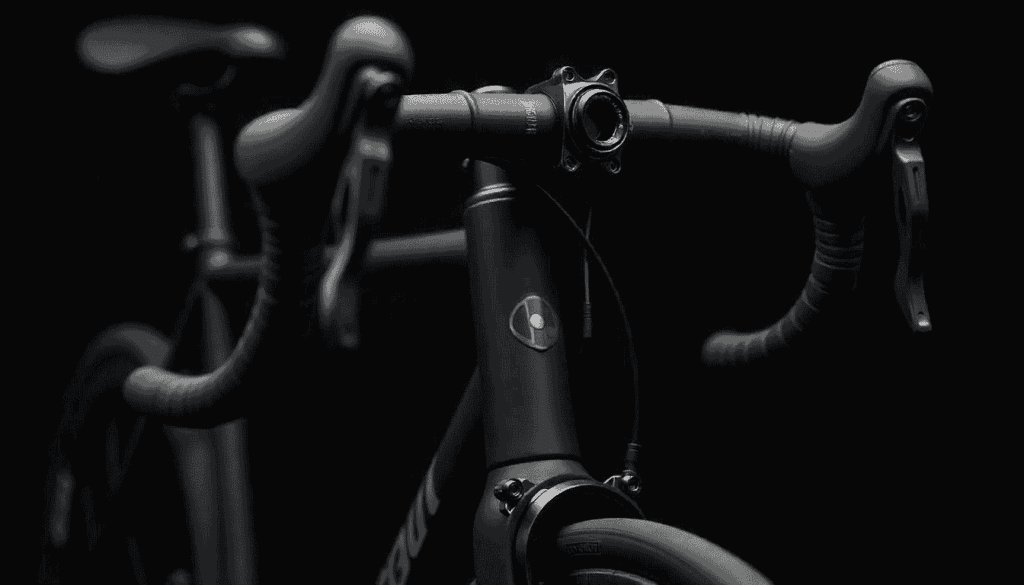When I first started cycling seriously, I didn’t realize just how significant the stem was. It looked like just another component—a basic bridge connecting the handlebars to the fork. But once I tried changing it out for a better fit, the effect on my bike’s handling, geometry, and ride position was massive. Suddenly, everything felt more in tune with my body. That small part, often overlooked, turned out to be essential to getting the most out of every ride.
So, what are bike stems really all about? They are the most important part of the bike that connects the steerer tube to the handlebars. Their length and angle shape how your bike behaves and feels. If you’re thinking about upgrading, you’ll want to consider the material, compatibility with your handlebar and steerer, and how it plays into your bike’s overall setup. This section isn’t just about theory—I’ve personally seen riders transform their comfort and control with the right stem swap.
Related: What Is a Derailleur on a Bike?
What are bike stems?
In order to link the handlebar to the fork via the steerer tube, the stem is crucial. It works by clamping the steerer tube in place, using pinch bolts to hold everything securely within the headset. The stem itself typically has a faceplate that is connected to the handlebar with four bolts, two at the top and two at the bottom. When it comes to material, the stem is commonly made from aluminum or carbon fiber, but titanium is also occasionally used for higher-end builds.
The length of the stem is crucial as it can have a significant impact on the fit and handling of your bike. Additionally, there’s often a slight angle between the steerer tube clamp and the long axis of the stem. This small detail can affect how your bike rides and feels. While these are the basics, there are always exceptions and complications depending on the specific design and use case of the bike.

The geometry of a bike stem
Stem length
When adjusting your bike’s stem length, it’s important to understand how it affects your ride. The length is one of the most critical factors to consider when you want to change the stock option on your bike. For mountain bikes, stem lengths typically range from 50-80mm, while road bike stems tend to be longer, starting at 80mm and extending up to 120mm or more, especially as the frame size increases. Gravel bike stems usually sit somewhere between the two, offering a balance for mixed-terrain rides.
The head tube angle and fork rake also play roles in a bike’s handling, but stem length remains a primary factor. Generally, a shorter stem will result in faster handling, making it easier to navigate tight turns, while a longer stem creates slower, more predictable handling, which can give you more stability during high speeds or on rougher terrains. Adjusting your stem for fine-tuning can help you find the perfect balance between maneuverability and control.
If you’re looking to adjust your position on the bike, stem length can help. A shorter stem brings the handlebar closer, providing a more upright position, which can be helpful if you feel stretched out during long rides. On the other hand, a slightly longer stem can offer more reach, making your riding position less cramped. Experimenting with different stem lengths allows you to make incremental adjustments for a more comfortable fit, but if you’re serious about finding the perfect setup, a professional fit can help ensure that your stem length complements the rest of your riding position and influences the overall setup of your bike.
Related: What is a headset on a bike?
Stem rise
The rise of a stem refers to the angle between the stem and the fork’s steerer tube. Typically, the rise can range from six degrees to 20 degrees, with most off-the-shelf bikes having a moderate amount of rise. If you’re looking for more control over your handlebar position, stems with a more extreme rise allow for greater adjustment. By adjusting the angle of the stem, you can tilt it down to get a more aerodynamic position or up for a more upright feel, depending on your riding needs.
Additionally, handlebar height can also be adjusted by adding spacers under the stem or using a riser bar for mountain bikes. These adjustments offer riders a designed option to achieve a comfortable fit that enhances performance. With the ability to adjust the amount of rise, riders can find the perfect balance of comfort and handling, whether they’re looking for more speed or a lower position for stability.
Stem diameter
When selecting a stem, you need to consider the diameters of both the steerer tube and the handlebars. These come in different standards, which can cause some confusion. The steerer tube diameter is usually quoted in inches, with the typical size being 1-1/8in, although some bikes use a 1-1/4in diameter. For handlebars, the diameter is typically measured in millimeters, and modern road bike bars usually have a 31.8mm diameter at the center. However, older bars typically had a diameter of 25.4 mm.
For mountain bikes, 31.8mm is the most common diameter, but you might also come across bars with a 35mm diameter. The faceplate of the stem must match the handlebars’ diameter to ensure a proper fit. The range of sizes means you’ll need to be careful to choose the correct diameter for your bike, especially since the quoted sizes can vary.

How to measure stem length
To measure the length of a stem, you’re not concerned with the overall distance from the front to the back. Instead, you’re measuring the distance from the central point on the steerer tube to the center of the handlebar. This is easy to do with a ruler or tape measure. The length will usually be a discrete number in millimeters—typically 80mm, 90mm, or 100mm, though some short stems can be as small as 35mm.
Helpful information is often printed on the stem itself, including its length, rise, and clamp diameter. This additional information can help you choose the right stem for your bike setup. The measurements you take ensure that the stem fits correctly and functions as intended, making your ride more comfortable and efficient.
Adjusting a bike stem
When adjusting your bike stem, there are several ways to improve its setup, fit, and handling. If your fork feels loose or tight within the frame, you can fix this by loosening the stem bolts, pre-loading the bearings to the appropriate level, ensuring there’s no play, and that everything turns smoothly. Once adjusted, re-tighten the stem to secure it all in place.
You can also change the height of your handlebars by moving spacers above or below the stem. This lets you move the handlebars to the height you want. Leaving the fork steerer long at first gives you leeway to make these changes later. When using a carbon fiber fork, always place a spacer on top of the stem. This ensures that the full length of the stem clamp engages with the steerer, reducing the risk of damage.
For more precise control, you can adjust the angle of your handlebar by rotating it within the stem clamp. This is possible if your bike has a conventional setup, with the handlebar and stem separate. For hybrid or mountain bikes, you can adjust the rotation of the flat bar to change the back sweep and rise of the handlebar.
For road or gravel bikes with drop handlebars, changing the rotation of the bars will alter how the handlebar drops and how the gear and brake levers are positioned. This fine-tuning allows you to adapt the angle of your handlebars for a more effective and comfortable riding experience.

2. Factors Affecting the Cost of Motorcycle Wrapping
Road bike stems
When it comes to road bike stems, most bikes come with stems ranging from 80mm to 120mm, with 100mm or 110mm being the most common for medium-sized bikes. These longer stems provide stability for the fast, wide turns typical of road cycling, making them quite different from the shorter stems found on mountain bikes. The extra length helps road cyclists maintain a racier, stretched-out, and aerodynamic riding position, which is essential for speed on the road.
For pro riders, stems can be even longer, often reaching 140mm or more. These riders favor an extreme, flat-backed position, allowing them to achieve better aerodynamics and speed. While the longer stems may seem excessive, they are designed for highly trained athletes with specific flexibility and stretching regimens that help support such a position. For everyday cyclists, a medium to shorter stem may be more comfortable and provide a better balance between aerodynamics and stability.
Many road bikes now come with alloy stems that feature external cabling, though more bikes are moving towards internal cable routing for a cleaner look and better aerodynamics. More and more high-end road bikes have handlebars and stems that are built into one piece. These setups provide a rigid and aero structure, reducing the drag caused by visible cables. However, they often come at the cost of adjustability since you can’t change the stem length or bar width without replacing the entire system.
Some brands, like Cannondale with its HollowGram SAVE system on the SuperSix EVO or Specialized with the Tarmac SL7, offer a design that balances aerodynamics with the ability to make adjustments. If you want to hide the wires and improve aerodynamics, you can use an aftermarket system like the FSA ACR to route them under the stem. This makes it easy to maintain and lets you fully adjust the handlebars and stem.

Mountain bike stems
The stems of mountain bikes are usually substantially shorter than those of road cycles. This is due to the bike’s geometry, which is often longer and slacker to help with fast steering and quicker response on rough trails. A shorter stem helps maintain this fast steering response, which is crucial for navigating tight turns and obstacles. It also helps keep the bike’s reach in check, making the ride feel more controlled.
Your stance on the bike is also impacted by the shorter stem. A shorter stem helps to shift your weight farther behind the front tire, increasing stability as you’re descending. However, climbing becomes easier with a slightly longer stem because it can help balance the bike’s weight better. As the handlebar is turned closer to the steerer’s axis, maneuverability likewise increases. But keep in mind that a stem that’s too short can make the bike feel unstable.
Other important features like the width and backward sweep of the bars also play a role in manoeuvrability, as they can bring your hands closer to the steering axis. Nowadays, mountain bikes are coming with integrated cockpits and hidden cable routing, especially on cross-country and race-focused bikes.

Direct-mount mountain bike stems
Downhill mountain bikes frequently utilize a direct-mount stem. It is more rigid and less likely to twist in a collision since it fastens directly to the fork crown rather than fastening to the steerer tube. This design is also lighter, which is crucial for high-speed downhill riding. Typically, direct-mount stems are ultra-short, giving riders sharp steering for technical courses that demand quick and precise control. This variant is becoming the trend for many downhill enthusiasts, offering a more robust and efficient setup for demanding trails.
Gravel bike stems
On gravel bikes, stems usually fall somewhere between those found on road and mountain bikes in terms of length. Newer gravel bikes typically use shorter stems, usually around 90mm or less, for better maneuverability. This is similar to the design choice seen in modern mountain bikes.
The shorter stem works better with the slacker headtube angles found on newer gravel bike designs, such as the Trek Checkpoint, making the bike feel more agile and responsive on both off-road and road sections. This design allows riders to have a smoother, more comfortable ride, with the slacker geometry improving control over various terrains.
Quill stems
The quill stem was used on old-school bikes, featuring an inverted L-shape with the shaft of the stem slotting into the top of the fork’s steerer tube. It was secured with an expander bolt that typically required an Allen key. While quill stems were once popular, they have been replaced by the more contemporary, bolt-on stem designs. The newer designs are stronger, lighter, and easier to manufacture since they don’t require the steerer tube to be threaded or the screw-on top headset bearing.
Despite their outdated design, you can still find quill stems on some retro-style bikes like fixies, single-speed bikes, and even some boutique custom builds. They are also still seen on cheaper town bikes that prefer the classic look or simpler build. Quill stems remain a symbol of the earlier days of cycling but have mostly been phased out for more efficient designs.
Bike stem standards
When choosing the right bike stem, the complexity comes from understanding the different standards available in the bike industry. Bike stems may look simple, but their compatibility with the steerer tube and handlebar clamp is crucial. The steerer tube is typically measured in inches, while the handlebar clamp is measured in millimeters, making it essential to know these measurements for proper fit.
There are several STEM standards to choose from, and the most common ones are typically summarized for easy comparison. Some bikes, like the Canyon Aeroad CFR, use a proprietary system, which adds another layer of complexity. While many options exist in the market, these are the common standards you’ll encounter.
1 1/8in steerer, 31.8mm bar clamp: found on contemporary road and mountain bikes, with normal stem lengths ranging from 80 to 100 mm for dirt bikes and 35 to 80 mm for MTBs.
1 1/4in steerer, 31.8mm bar clamp: Common on some mountain bikes and drop-bar bikes, such as Giant’s cyclocross bikes.
1 1/8in steerer, 35mm bar clamp: Found on mountain bikes with oversized handlebars.
1 1/4in steerer, 35mm bar clamp: Used when the steerer tube on mountain bikes is beefed up for more strength.
Direct mount: Common on downhill mountain bikes, requiring a fork with built-in mounting points.
1 1/8in steerer, 25.4mm/26mm bar clamp: Typically seen on older mountain and road bikes.
1in steerer, 25.4mm/26mm clamp: Used for quill stems on older bikes.
Suspension stem: Adds compliance to the handlebar, usually using polymer inserts or springs to smooth out the ride.

Bike stem materials
Carbon vs alloy
When choosing between carbon and aluminium alloy for your bike stem, there are some key factors to consider. Standard stems on most bikes are made of aluminium alloy, a material known for being durable, lightweight, easy to manufacture, and affordable. This makes it a popular choice for everyday riders who want reliability without breaking the bank. Aluminium alloy also offers a good balance between strength and weight, making it ideal for most cycling needs.
On the other hand, carbon is often used for high-performance bikes. For instance, a carbon road bike stem may offer a slight weight saving, but this comes at a higher price. The real benefit of carbon comes with proprietary integrated systems, where its ability to form complex shapes and allow for internal cable routing makes it easier to design single-piece bar/stems. Carbon fibre is also used in oversized stems to increase stiffness, a feature often seen in the bikes of top-level sprinters who need maximum performance. However, the weight saving from using carbon in a short mountain bike stem is often negligible, so the choice comes down to performance needs and budget.
Titanium bike stem
Titanium bike stems are well known for their remarkable strength and resilience, providing comfort and shock absorption. With a tensile strength of 800-900 MPa, these stems provide a resilient structure that remains strong yet reasonably lightweight. The compliance of titanium helps absorb road vibrations more effectively than other materials, making it a great choice for riders looking for a smoother ride, especially during gravel or endurance cycling.
Although titanium stems are generally heavier than carbon, their superior fatigue resistance and long-lasting reliability make them an excellent long-term investment for cyclists who prioritize comfort and performance without compromising durability. Whether you’re cycling on rough roads or long distances, a titanium stem can offer a balance of comfort, strength, and performance that will stand the test of time.
Steel bike stem
Steel bike stems are a popular option for commuters, touring bikes, and antique or retro-style bicycles due to their reputation for durability and affordability. Steel stems offer a strong, durable structure that can withstand the rigors of regular riding thanks to their tensile strength of 400–500 MPa.
Steel stems provide a sturdy and dependable riding, even though they are heavier than other materials. They can also sustain big loads and collisions. Steel stems’ timeless appearance and vintage feel make them ideal for bikes where durability and style are more important than weight reduction.
While the extra weight can affect handling agility, the tradeoff is well worth it for riders who value strength and longevity.
How to install a bike stem?
The first step in installing a bike stem is to line it with the steerer tube. Verify that the spacers are positioned correctly and that the steerer tube is clean. After that, attach the stem to the steerer tube and use an Allen key to uniformly tighten the stem clamp bolts. After that, you may insert the handlebar and use the faceplate to secure it. To provide uniform pressure, it’s crucial to tighten the bolts in a cross pattern. To make sure everything is tight enough, use a torque wrench and adjust according to the manufacturer’s recommended torque specification to guarantee safety.








